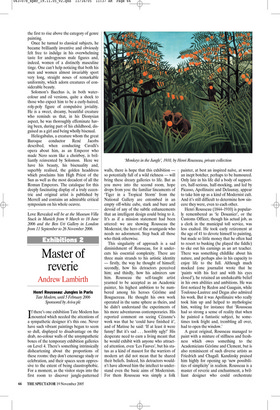Shipwreck of a genius
Tom Rosenthal
Love Revealed: Simeon Solomon and the Pre-Raphaelites Birmingham Museums & Art Gallery, until 15 January 2006 Simeon Solomon ‘has his place, not far from Burne-Jones, in any record of the painting of the 19th century. Had circumstances been kinder to him, or had he been other than himself, he would have been a formidable rival,’ wrote Arthur Symons in 1925. This Birmingham exhibition is the most comprehensive assessment yet of Solomon’s art, more wide-ranging than the last important show, held at the Jewish Museum in Camden Town in 2001 under the title From Prodigy to Outcast. Poor Solomon needs these evocative titles to pull people in because of his relative obscurity. Happily, the Birmingham show is sufficiently large and well curated that while the epithet poor will understandably remain the obscurity should surely fade.
Simeon Solomon was born in Bishopsgate in 1840, the last of the eight children of Michael Solomon, a prosperous Jewish hatter, and his wife Catherine Levy. In this cultivated household, the arts were encouraged and, in 1841, Simeon’s elder brother Abraham exhibited — aged 18 — for the first time at the Royal Academy. There is an enchanting baby portrait of Simeon by Abraham in the exhibition. Simeon’s sister Rebecca (1832–86) was also a gifted artist but, overshadowed by Abraham, was very close to Simeon. After Simeon’s disgrace he was, in that cruelly hypocritical era, ruined both socially and artistically and, it was rumoured, succumbed to alcoholism.
Simeon’s disgrace, the reason why he became poor Simeon, was not that he was homosexual; there were as many gay men in the arts then as now. It was that he was caught having sex with a working-class man in a public lavatory off Oxford Street in 1873. His companion in crime got 18 months’ hard labour. Simeon got the same term, but with light labour, which was reduced to police supervision. Solomon might have survived this but, a year later, he was caught in the act with a Frenchman in a Parisian public lavatory and got three months and a 16-franc fine. After this it was a wretched, declining spiral. D.G. Rossetti told Jane Morris that Simeon had been admitted to hospital ‘not only ragged but without shoes!’ In 1885 he was admitted as a ‘brokendown artist’ to St Giles’s Workhouse in Endell Street and lived there intermittently until his death, 100 years ago, on 14 August, officially of heart failure. He was buried at Willesden Jewish Cemetery. In 1906 his work was heavily represented in the winter exhibition of the Old Masters and Deceased Masters at the RA, and 53 of his works, with others by Abraham and Rebecca, were shown in an exhibition of Jewish art at the Whitechapel Gallery.
Solomon’s downfall affected his supporters in different ways. Walter Pater continued to write favourably about him, but Swinburne, hardly an advertisement for normal sex, immediately dropped him. Yet before that he had powerful, discriminating admirers. William Michael Rossetti referred to him in these columns in 1858 as ‘that singular young genius’, and William Blake Richmond, in 1926, described him as ‘a genius entirely unique’. He had the friendship of William de Morgan and Albert Moore, as well as that of Richmond. The Pre-Raphaelites were also friendly, and, as the Birmingham show makes clear, he was, for most of the time, well up to their standards. Holman Hunt sought his advice and Arthur Symons was referring to his life rather than his art when he described him as ‘a shipwreck of a genius’.
Solomon was a witty, satirical draughtsman who could mock the Pre-Raphaelite Brotherhood’s preoccupation with Sir Galahad in a sketch entitled ‘Sir Galipot bearing the Holy Gruel’. His early works, unsurprisingly, on Jewish themes such as the rituals of domestic and synagogue life, were among the first, and the finest, of post-Jewish emancipation art. The emancipation circumvented the prohibition of ‘graven images’ and exploited the subsequent licence to paint realistic pictures rather than the endemic, restricted, nearabstract imagery of traditional Jewish art. His Jewish pictures are almost certainly the first to rise above the category of genre painting.
Once he turned to classical subjects, he became brilliantly inventive and obviously felt free to indulge in his overwhelming taste for androgynous male figures and, indeed, women of a distinctly masculine tinge. One can’t help noticing that both his men and women almost invariably sport very long, straight noses of remarkable uniformity, which adorn creatures of considerable beauty.
Solomon’s Bacchus is, in both watercolour and oil versions, quite a shock to those who expect him to be a curly-haired, roly-poly figure of compulsive joviality. He is a sweet, dreamy, beautiful creature who reminds us that, in his Dionysian aspect, he was thoroughly effeminate having been, during part of his childhood, disguised as a girl and being wholly bisexual.
Heliogabalus, a creature whom the great Baroque conductor René Jacobs described, when conducting Cavalli’s opera about him, as an Emperor who made Nero seem like a choirboy, is brilliantly reinvented by Solomon. Here we have his beauty, his bisexuality and, superbly realised, the golden headdress which proclaims him High Priest of the Sun as well as the most decadent of all the Roman Emperors. The catalogue for this deeply fascinating display of a truly eccentric and original artist is published by Merrell and contains an admirable critical symposium on his whole oeuvre.


























































 Previous page
Previous page